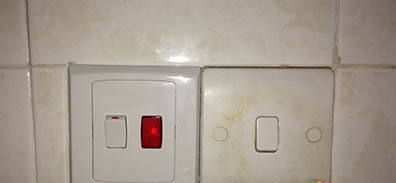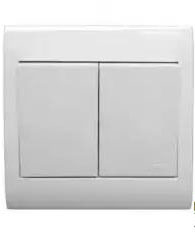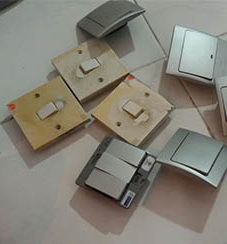HOW TO PICK THE RIGHT ELECTRICAL SWITCHES FOR A SMALL WORKSPACE
There is no doubt that a safe workplace ensures a safe workforce – and the one aspect that plays a big role in safety at work is the use of right electrical switches. This is especially true when you are dealing with a small workspace where the switches are used frequently and over long working hours. While there are a plethora of elements that come to play in choosing electrical switches, read on for the most prominent factors you need to keep in mind to design a small office.
The type of switch
From switches exclusively designed for machinery to aesthetically pleasing ones that complement your office decor, there is a multitude of types to choose from for a small workspace. Mentioned below are some of the common types of electrical switches that strike the right balance between functionality and practicality.
Toggle Switches
Not only are toggle switches unique but they are also user-friendly because they have only one output and input. An electrical circuit is opened and closed when the switch is moved back and forth. The easy-to-use nature of this switch makes it ideal for workspaces, especially due to the simple mechanism it offers. These type of switches are also used in certain types of machinery and electronic planes.
Multi-Location Switch
Multi-location switches add value to small workspaces as they can be installed in many locations at the same time with multiple access points. This type of switch is an interconnection between two or more electrical switches. They are ideal for hallways or open spaces and add to safety and convenience. In fact, they are the most preferred choice for small workspaces because if one component fails the other switch can be used to control the fixture.
Double-Pole Switches
Unlike single-pole switches which can only break the connection between terminals for a single fixture, double-pole switches are used to control two fixtures. This type of switch is ideal for a small workspace because it can control two fixtures without having the need to install a separate box for each fixture. Additionally, the fixtures are mechanically operated by the same button making it easy to install, operate and replace if necessary. The usability of double-pole switches is what makes them a good choice for small organisations where two fixtures can be operated at the same time.

factors for finding the perfect switch for your application
The process of selecting switches does not always receive the time and attention it deserves. Given the relatively low cost and simple nature of most switches, often they are selected without full consideration of the features and functionality they offer. Depending on the application, there are certain parameters that will guide a designer to choose a particular switch, but amidst the myriad of options that are available it is all too easy to be led astray.
Driven by Data
The advent of the Internet of Things (IoT) is generating vast amounts of data across all sectors. This data needs to be stored or, more often, communicated. The necessity of accommodating the required antennas, transmitters and additional circuitry can have a drastic impact on the space available for operational, detection and data collection components, such as switches. Despite this, switches must still interface with the user, while also withstanding harsh environments and aggressive interaction. Manufacturers of medical equipment, for example, are increasingly focusing their investments on developing the systems and platforms to store, correlate and analyze this data. Designers must therefore carefully select switches that are capable of meeting demanding specifications, including miniaturization and low power consumption.
Meeting Physical Demands
With the growth of wearables, the demand for switches is growing. While wearable devices have been around for some time, there are different philosophies when it comes to designing devices for different industries. Components within medical wearable devices, for example, need to be resilient against rough treatment and environmental challenges, while also working the first time, every time. The challenge for designers is to ensure that every individual component is fit for purpose within the demanding environments in which these machines operate. Switches are a vital part of the interface between a user and a device, so when it comes to ensuring consistent performance, long life and quality of the switches, making the correct choice is crucial.
Form Factor
Within the industrial sector, for example, switches are used in a variety of applications including CNC machine controls, safety and position sensors, battery chargers, power supplies and gas detection equipment, to name but a few. One thing they all have in common is that space is limited on the PCB, both when it comes to height and footprint. This form factor is becoming increasingly important as the functionality of devices increases, making the real estate on the PCB even more valuable.
Electrical Rating
Another crucial consideration for switch choice is the required signal current. There is a great variety in electrical requirements depending on the product design, with some switches needing to handle low signal currents for PLCs and microprocessor inputs, while some need to handle higher currents in order to actuate relays.

CHOOSING LIGHT SWITCHES FOR YOUR HOUSE
Types of Light Switches
Single Pole / 1-Gang Switch: This type of light switch is considered to be one of the most commonly used ones in Singapore. As such, a single pole switch uses a simple on and off toggle in order to control devices, receptacles, and lights from a single location. Flipping this switch on single pole models either connects or disconnects the circuit. You are required to wire the switch in a correct direction to ensure that the markings match the position of the light switches. Single-pole light switches are also likely to have two brass screws on either side of the switch. These brass terminals then house the incoming and outgoing hot wire. Additionally, a green ground terminal can also be found in such light switches.
3-Gang Switch: This kind of light switch usually comes in pairs and allows you to properly turn the lights on and off from two different locations. Usually, a 3-way switch is ideally installed in long hallways. A 3-way switch design is considered to be more complicated than other kinds of switches out there.
Double-Way Switch: Like single-pole light switches, a double-pole light switch also has a green ground screw and uses an on/off toggle and controls devices such as receptacles and lights from a single location. With its four brass terminals, it can effectively house two different hot wires. This indicates that these double-pole models can switch to a 240-volt circuit. Remember to hire a certified electrician in Singapore if you are thinking of installing double-way switches. This ensures that the light switches are properly and professionally installed.
Water heater switches usually come in 20amp and are recommended to be installed by a qualified electrician. This is because a water heater switch needs to be correctly wired to the water heater, as well as, your home’s circuit breaker or DB Box.
Dimmer switches are commonly installed for lights that have ambience lighting. Dimmer switches can come in many classic styles to fit the design of your home perfectly. It is best to replace or install a new dimmer switch if it emits a crackling sound, produce sparks, produces a flickering light, or simply not performing as well as it should be.

Factors to Consider Before Choosing Enterprise Switches
Nowadays, to set up an enterprise network, network switches for enterprise are necessary, connecting the users in local geography such as an office, departments or buildings connected to each other and allowing data transferring to the assigned devices. It is an indisputable fact that Ethernet switches matters a lot in an enterprise network, no matter it is small or large-sized. Before you make your choice of buying enterprise switches, here are some criteria you need to consider.
Map out the Enterprise Network
The most critical thing you should make clear is your requirements including the network size, the purpose of the network, the devices which will be connected to the switches and the future network planning.
Evaluating Enterprise Switches
After deciding the enterprise network architecture, you should get some information about enterprise switches which will help you better choose the switches you will deploy. If you are aware of the switch specifications, you can skip this part and go directly to the next which will give your suggestions on evaluating switch suppliers.
Port Speeds and Cabling Connections
There is a wide range of network switches available in the market. 1 Gigabit Ethernet, 10 GE, 40GE and 100GE ports are all supported by the modern enterprise switches. These interfaces can be a combination of RJ45 ports for copper connectivity and SFP or SFP+ uplink ports with higher speeds for fiber connectivity. In terms of the cabling connections, Ethernet connections with standard RJ45 ports can be more economical. Sure the network switch interface selection is influenced by the installed cabling. If you have already installed Cat6 or Cat6a cabling, then choose switches with RJ45 ports; If multiple fiber cabling is installed, then choose switches with SFP, SFP+, or QSFP+ ports. Despite the fact that Cat6 cable running from the access closet may be less expensive, the distance it can reach will be limited.
Installation Environments
Based on the environment where you are going to install switches, the switch size, the operating temperature, relative humidity are all your considerations. In a place where space is limited, you must examine the switch dimensions and ensure the rack space is adequate for the switch deployment. If the temperature of the installation environment is either too hot or too cold, it is necessary to check and choose the switch which can operate in a harsh environment. Also, be careful about the moisture migration and penetration caused by high humidity which will impact the operation of the devices.

How to Install a Dimmer Switch
Installing a dimmer switch is one of the easiest DIY electrical projects you can do. Read these steps on how to install one in your home.
ControllingControlling the level of lighting in a room is a great way to set a mood. While you may want brighter light for reading, you might want less light for watching TV, and perhaps even a third level of light for a romantic evening at home. Dimmer switches can accommodate all of these circumstances.
Make Sure Switches and Light Bulbs are Compatible
Not too long ago, the only dimmer switches you could buy were rheostats that reduced the amount of electricity going to the light by turning some of it into heat at the switch.
How to Wire a Dimmer Switch
One difference between dimmer switches and regular switches is that with the latter, the house wires attach directly to the switch. Most dimmers, on the other hand, come with integral wire leads that connect to the house wires using wire nuts.
What Are Three-Way Dimmers?
A three-way circuit controls a light from two locations and requires special switches. Four-way circuits are similar but control the light from three or more locations. Rather than using cable with two insulated wires (one black and one white) plus a bare ground, these circuits use cable with three insulated wires (black, white, and red) plus a bare ground.